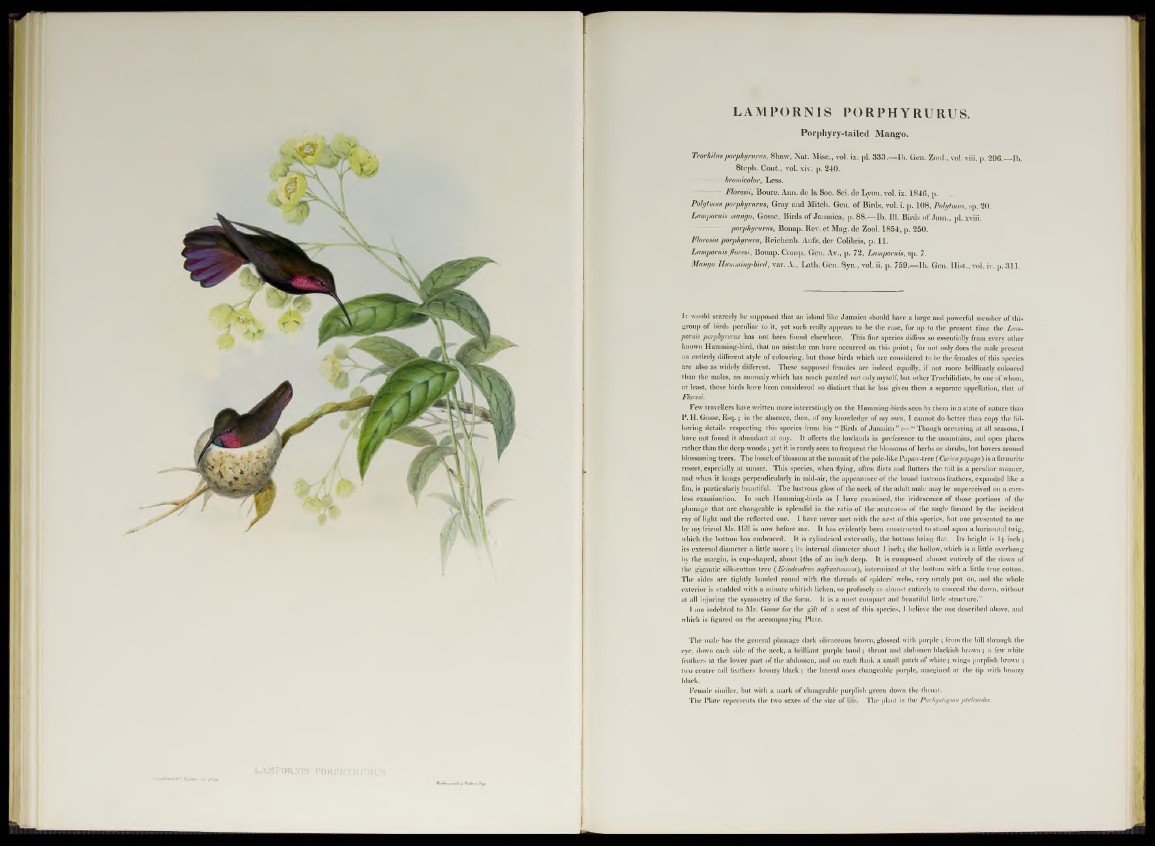
J CmMarUH C Ridder. iel el htii
LAMPORSIiS PO jR PH Y R rR U S ,
LAMPORNIS PORPHYRURUS.
Porphyry-tailed Mango.
Trochiluspoiphyrurus, Shaw, Nat. Misc., vol. ix. pl. 333.— Ib. Gen. Zool., vol. viii. p. 296. Ib.
Steph. Cont., vol. xiv. p. 240.
-----------bromicolor, Less.
—J Floresii, Bourc. Ann. de la Soc. Sci. de Lyon, vol. ix. 1846, p.
Pohjtm-us poiphyrurm, Gray and Mitch. Gen. of Birds, vol. i. p. 108, Polytmus, sp. 20.
Lampornis mango, Gosse, Birds of Jamaica, p. 88.—Ib. 111. Birds of Jam., pl. xviii.
— porphyrurus, Bonap. Rev. et Mag. de Zool. 1854, p. 250.
Floresia porphyi'ura, Reichenb. Aufz. der Colibris, p. 11.
Lampornis Jloi'esi, Bonap. Consp. Gen. Av., p. 72, Lampornis, sp. 7.
Mango Humming-bird, var. A., Lath. Gen. Syn., vol. ii. p. 759.—Ib. Gen. Ilist., vol. iv. p. 311.
I t wonld scarcely be supposed that an island like Jamaica should have a large and powerful member of this
group of birds peculiar to it, yet such really appears to be the case, for up to the present time the Lampornis
porphyrurus has not been found elsewhere. This fïne species differs so essentially from every other
known Humming-bird, that no mistake can have occurred on this point; for not only does the male present
an entirely different style of colouring, but those birds which are considered to be the females of this species
are also as widely different. These supposed females are indeed equally, if not more brilliantly coloured
than the males, an anomaly which has much puzzled not only myself, but other Trochilidists, by one of whom,
at least, these birds have been considered so distinct that he has given tliem a separate appellation, that of
Floresi.
Few travellers have written more interestingly on the Humming-birds seen by them in a state of nature than
P. H. Gosse, Esq.; in the absence, then, of any knowledge of my own, I cannot do better than copy the fol-
lowing details respecting this species from liis “ Birds of Jamaica” :—“ Though occurring at all seasons, I
have not found it abundant at any. It affeets the lowlands in preference to the mountains, and open places
ratlier than the deep woods; yet it is rarely seen to frequent the blossoms of herbs or shrubs, but hovers around
blossoming trees. The bunch of blossom at the summit of the pole-like Papaw-tree ('Caricapapaya) is a favourite
resort, especially at sunset. This species, when flying, often flirts and flutters the tail in a peculiar manner,
and when it hangs perpendicularly in mid-air, the appearance of the broad lustrous feathers, expanded like a
fan, is particularly beautiful. The lustrous glow of the neck of the adult male may be unperceived on a care-
less examination. In such Humming-birds as I have examined, the iridescence of those portions of the
plumage that are changeable is splendid in the ratio of the acuteness of the angle formed by the incident
ray of light and the reflected one. I have never met with the nest of this species, but one presented to me
by my friend Mr. Hill is now before me. It has evidently been constructed to stand upon a horizontal twig,
which the bottom has embraced. It is cylindrical externally, the bottom being flat. lts height is l£ inch;
its external diameter a little more; its internal diameter about 1 inch; the hollow, which is a little overhung
by the margin, is cup-shaped, about £ths of an inch deep. It is composed almost entirely of the down of
the gigantic silk-cotton tree (Eriodendron anfractuosum), intermixed at the bottom with a little true cotton.
The sides are tightly banded round with the threads of spiders’ webs, very neatly put on, and the whole
exterior is studded with a minute whitish lichen, so profusely as almost entirely to conceal the down, without
at all injuring the symmetry of the form. It is a most compact and beautiful little structure.”
I am indebted to Mr. Gosse for the gift of a nest of this species, I believe the one described above, and
which is figured on the accompanying Plate.
The male has the general plumage dark olivaceous brown, glossed with purple ; from the bill through the
eye, down each side of the neck, a brilliant purple band ; throat and abdomen blackish brown; a few white
feathers at the lowcr part of the abdomen, and on each flank a small patch of white; wings purplish brown ;
two centre tail feathers bronzy black ; the lateral ones changeable purple, margined at the tip with bronzy
black.
Female similar, but with a mark of changeable purplish green down the throat.
The Plate represents the two sexes of the size of life. The plant is the Pachystigma pteleöides.